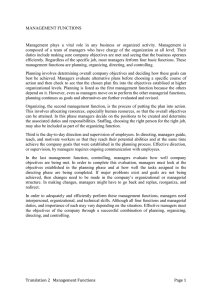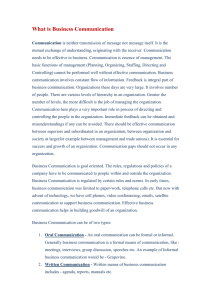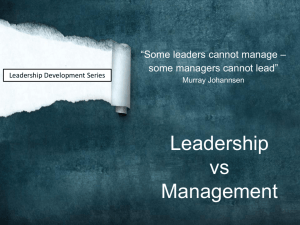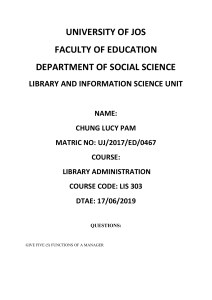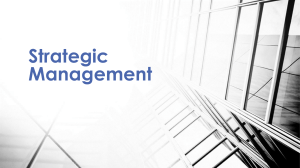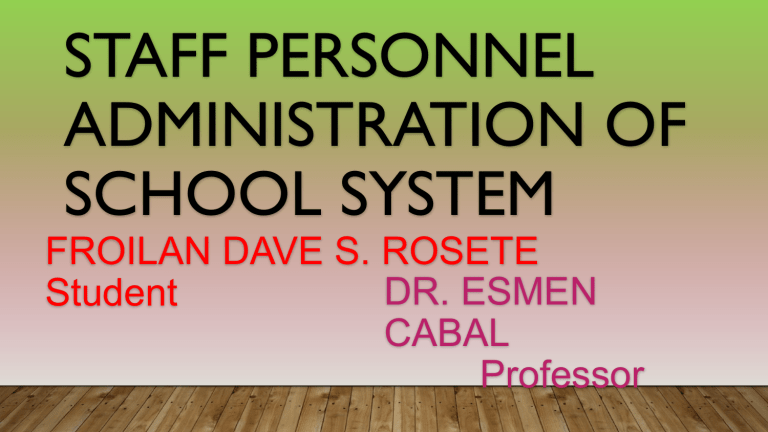
STAFF PERSONNEL ADMINISTRATION OF SCHOOL SYSTEM FROILAN DAVE S. ROSETE DR. ESMEN Student CABAL Professor INTRODUCTION Human resources have a big role in the implementation of education. Education which is a process cannot be separated from the role of human resources because one of the important aspects is human resources themselves. In addition, humans always play an active role in every activity of the organization, because humans sometimes become planners, actors, and determinants of the realization of organizational goals. Objectives are not possible without the active role of employees even though the tools of the company are sophisticated 5 This also applies in the world of education, because more specifically the learning process played by educators cannot be replaced by technology. To make human resources function more effectively and efficiently, good management is needed, starting from planning to the final stage in the management function. Discussing the existence of human resources (HR) in educational organizations is a natural thing because in the process of education human resources (HR) have a large role both in terms of administrative and operational. Human resources (HR) need to be managed properly so that they can play roles according to their functions. That is why the need for human resource management (HR). 6 The word management comes from Latin, namely from the origin of the word manus which means hand and agree which means to do. The words are combined into manager verbs, which mean handling. Managers is translated into English in the form of verbs to manage, with the noun management, and managers for those who carry out management activities 7 Marry Parker Follet defines management as the art of getting work done through people. This definition means that a manager is tasked with managing and directing others to achieve organizational goals. James Stoner Ricky defines management as a process of planning, organizing, leadership and controlling the efforts of organizational members and the use of all organizational resources to achieve the goals set effectively and efficiently 8 Educational management is an arrangement in the field of educational work carried out through planning, organizing, staffing, coaching, coordinating, communicating, motivating, budgeting, controlling, evaluating and reporting activities systematically to achieve quality educational goals. From the various statements above, a conclusion can be drawn that education management is a system of management and utilization of all educational resources to carry out systematic and systemic cooperation processes so that effective education implementation can be realized and efficient in order to realize the national education goals that have been aspired. 9 STAFF ADMINISTRATION & PERSONNEL MANAGEMENT ⇨ (1). Andrew F Sikula, stated that staffing administration is the placement of people into an organization / institution. Implementation of human labor is the procurement, maintenance, placement, indoctrination, training and education of human resources. ⇨ (2) Edwin B. Flippo, stated that personnel management is the process of planning, organizing, directing and controlling the procurement of labor, development, compensation, integration, maintenance and termination of employment with a view to achieving the goals or objectives of individuals, organizations, and the community their work or work relationship. 10 ⇨ (3) John B. Miner and Mary Green Miner, stated that personnel management is defined as a process of developing, implementing, and evaluating policies, procedures, methods, and programs relating to individual employees in the organization. Michel J. Julius, stated that personnel management is the field of management which is related to the planning, organizing, and controlling various functions of procurement, development, maintenance, and utilization of labor so that ⇨ (a) the purpose for which the association is established and achieved efficiently and effective, ⇨ ⇨ (b) the goals of all employees are served to an optimal level, (c) the goals of the community are taken care of and served well. 11 NATURE OF PERSONNEL MANAGEMENT ⇨ Basically, the function of the personnel department is to plan the concept of extension, development and improvement of the quality of human resources needed by the company. Policies relating to labor regulations, recruitment qualifications, and career development from sending labor to attend training to continuing studies, incentive programs or bonuses for labor are the main functions of this personnel. ⇨ Human resource management can be defined as a process and effort to develop, motivate, and evaluate the overall human resources needed by the company in achieving its objectives. This understanding includes starting to choose anyone who has the qualifications and suitable to occupy a position in an organization (the right man on the right place) as required by an institution or organization to how to make this qualification can be maintained even increased and developed from time to time. Because human resource management is an ongoing process, in line with the education process, attention to human resources can have a special place in educational organizations 12 ⇨ The functions of human resource management include planning, organizing, mobilizing, controlling, procuring, developing, compensating, integrating, maintaining, disciplining, and terminating company needs in helping the realization of goals. ⇨ (a) Organizing, is an activity to organize all employees by determining the division of labor, work relations to achieve goals. ⇨ (b) Directing (directing), is the activity of directing all employees, so they want to work together and work effectively and efficiently in helping the achievement of company, employee, and community goals. ⇨ (c) Control (controlling), is the activity of controlling all employees, so that they comply with company regulations and work according to plan. ⇨ (d) Procurement (procurement), is the process of withdrawal, selection, placement, orientation, and induction to get employees in accordance with company needs. 13 ⇨ (e) Development (development), is the process of improving technical, conceptual, and moral skills of employees through education and training. The education and training provided must be in accordance with current and future employment needs. ⇨ (f) Compensation (compensation), is the provision of direct and indirect services, money or goods to employees as compensation for services provided to the company. ⇨ (g) Integration (integration), is an activity to unite the interests of the company and the needs of employees, so as to create harmonious and mutually beneficial cooperation. ⇨ (h) Maintenance (maintenance), is an activity to maintain or improve the physical, mental, and loyalty of employees, so that they will continue to work together until retirement. ⇨ (i) Discipline, is the most important function of management of human resources and the key to the realization of goals because without good discipline it is difficult to realize maximum goals. Dismissal (separation), is the termination of a person's employment relationship from a company 14 ELEMENTS OF PERSONNEL MANAGEMENT ⇨ Organization- Organization is said to be the framework of many activities taking place in view of goals available in a concern. An organization can be called as a physical framework of various interrelated activities. Right from manpower planning to employees’ maintenance, all activities take place within this framework. The nature of the organization is dependent upon it’s goal. The business concern goal being profit- making. Clubs, hospitals, schools,etc. their goal being service. The objective of consultancy being providing sound advice. Therefore, it is organizational structure on which the achievement of goals of an enterprise depends upon. In personnel management, a manager has therefore to understand the importance of organizational structure. 15 ⇨ Job- The second element, i.e., jobs tell us the activities to be performed in the organization. It is said that the goals of an enterprise can be achieved only through the functional department in it. Therefore, seeing the size of organization today, the nature of activities are changing. In addition to the three primary departments, personnel and research department are new additions. Various types of jobs available are: ⇨ ⇨ ⇨ ⇨ ⇨ ⇨ Physical jobs Creative jobs Proficiency jobs Intellectual jobs Consultancy jobs Technical jobs 16 ⇨ People- The last and foremost element in personnel management is people. In a organizational structure, where the main aim is to achieve the goals, the presence of manpower becomes vital. Therefore, in order to achieve departmental goals, different kinds of people with different skills are appointed. People form the most important element because: The organizational structure is meaningless without it. It helps to achieve the goals of the enterprise. It helps in manning the functional areas. It helps in achieving the functional departmental goals. They make a concern operational. They give life to a physical organization. 17 ⇨ The different types of people which are generally required in a concern are: Physically fit people Creative people Intellectuals Technical people Proficient and skilled people ⇨ In personnel management, a personnel manager has to understand the relationship of the three elements and their importance in organization. He has to understand basically three relationships:- Relationship between organization and job Relationship between job and people Relationship between people and organization. 18 PROCUREMENT OF EMPLOYEES ⇨ Employee procurement is an activity to meet the needs of employees at an institution, both in number and quality. To get employees according to their needs, recruitment activities are carried out, which is an effort to find and get as many prospective employees who meet the requirements as possible, to then be selected the best and qualified candidates. For this purpose, selection is needed, through oral, written, and practical examinations. But sometimes, in an organization, the procurement of employees can be brought in internally or from within the organization, whether through promotion or transfer. This is done if the formation is empty a bit, while in other parts there are excess employees or are already prepared. 19 EMPLOYEE DEVELOPMENT ⇨ The organization always wants its personnel to carry out their duties optimally and contribute all their abilities to the interests of the organization, and work better from day to day. Besides that, the employee himself, as a human being, also needs improvement and improvement in him, including in his duties. In this regard, the function of developing and developing employees is a function of managing personnel that is absolutely necessary, to improve, maintain and improve employee performance. This coaching and development activity does not only concern the ability aspect, but also involves the career of the employee. Employee development is considered increasingly important because of the demands of work or position, as a result of technological advances and increasingly intense competition among similar organizations / institutions 20 PROMOTION AND MUTATION ⇨ Promotion is a move that increases employee authority and responsibility to a higher position in an organization so that the obligations, rights, status, and income are even greater. Promotion means that there is trust and recognition regarding the ability and ability of the employee concerned to occupy a higher position. That way employees will be encouraged to work hard, be enthusiastic, be disciplined, and achieve work so that the goals of the organization / institution can be optimally achieved. One of the follow-up actions taken from the results of employee performance appraisal is employee mutation. Because the employee performance appraisal will be known employee skills in completing job descriptions that are charged to him. This mutation must be based on the achievement index that can be achieved by relevant employee. It can be concluded that mutations are included in the employee development function, because the aim is to improve work efficiency and effectiveness in organizations / institutions 21 DISMISSAL OF EMPLOYEES Termination is the termination of employment of an employee of an employee with an organization / institution. With dismissal, it means the end of employee work engagement with the organization. Dismissal of employees is a personnel function that causes the release of organizations and personnel from the rights and obligations as a workplace institution and as an employee. In relation to education staff in schools, especially Civil Servants the reasons for terminating these employees can be grouped into three types, namely: ⇨ ⇨ ⇨ (a) Termination at own request. (b) Dismissal by the department and the government, (c) Termination of other causes. 22 Dismissal at the request of the employee himself, for example due to a change of employment aimed at improving the lot Dismissal by the department or government can be done for the following reasons: ⇨ (a) The employee concerned is incompetent and does not have the ability to carry out his duties properly. ⇨ ⇨ (b) Streamlining or simplifying the organization. (c) Rejuvenation, usually employees who are 55 years old and are entitled to retire must be dismissed within one year. ⇨ (d) Not healthy spiritually and physically so that they cannot carry out their duties properly. ⇨ ⇨ (e) Committing an offense so that he is sentenced to prison or confinement. (f) Breaking a civil servant’s oath or promise 23 COMPENSATION ⇨ Compensation is a remuneration provided by the organization to employees, which can be valued in money and has a tendency given permanently. Provision of compensation other than in the form of salary can also be in the form of benefits, housing facilities, vehicles, and others 24 EMPLOYEE ASSESSMENT ⇨ To see whether employees who are trained and developed benefit from what they do, it is necessary to evaluate or evaluate their achievements. Work performance is the result of quality and quantity of work achieved by an employee in carrying out their duties in accordance with the responsibilities given to him. For the assessment of education personnel is focused on individual achievement and participation in school activities. For employees, assessment is useful as feedback on various things, such as ability, fatigue, lack, and potential which in turn is useful for determining goals, paths, plans, and career development. For schools, the results of performance appraisal of education staff are very important in making various decisions, such as identification of school program needs, acceptance, selection, introduction, placement, promotion, reward systems, and other aspects of the overall effective process of human resources 25 REFERENCES: ⇨ Bahdin Nur Tanjung, Human Resources in Education Management ⇨ https://www.managementstudyguide.com/elements-ofpersonnel-management.htm ⇨ https://www.managementstudyguide.com/personnelmanagement.htm 26 END 27


